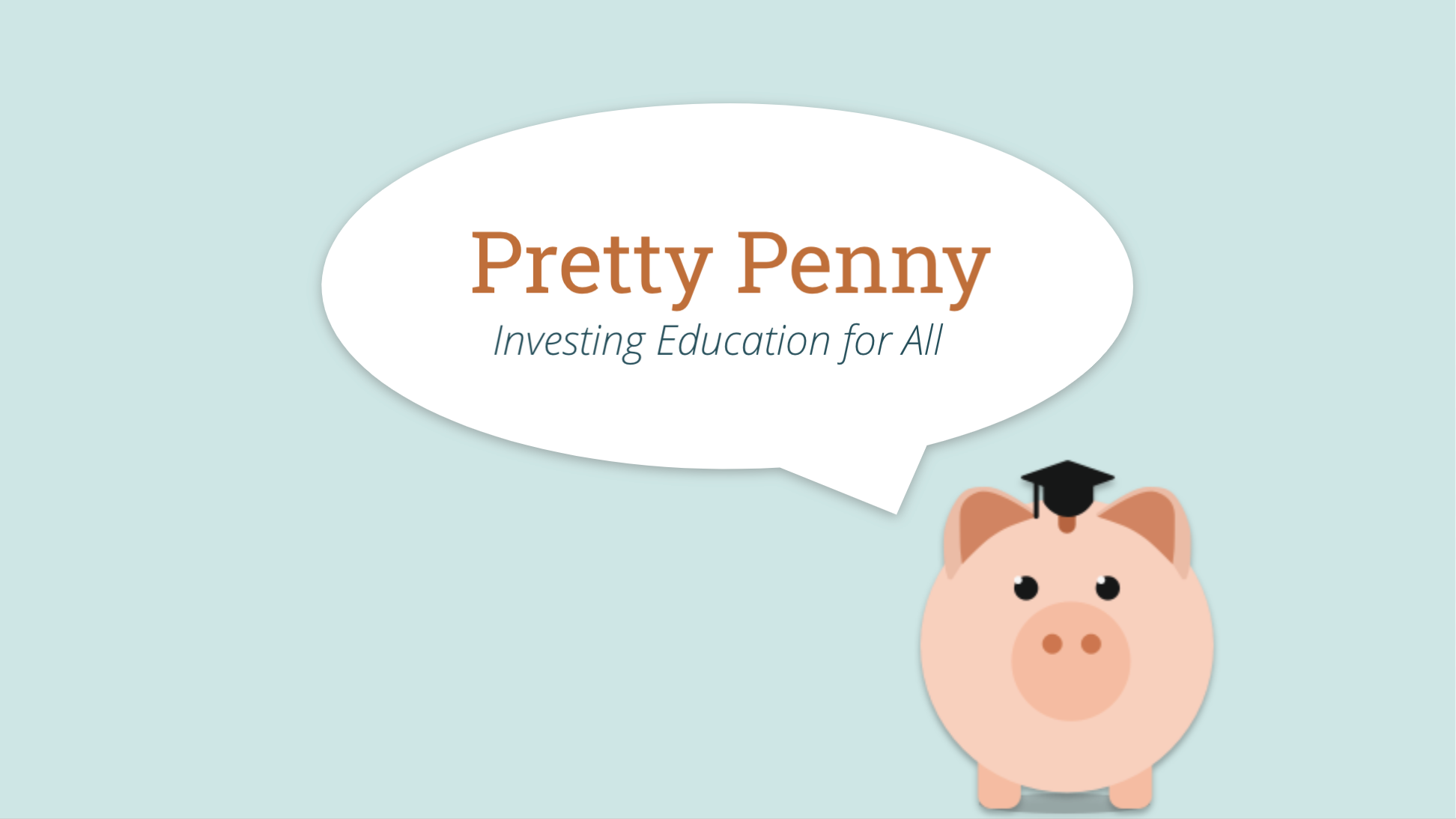
Background
Since high school, I knew I wanted to invest because 1) it’s interesting and 2) who doesn’t want to make passive income. When I got older and wanted to start, there was the problem, I didn’t know where to start. Nowadays there’s so much information out there that it gets confusing. Then we have to consider what platforms or apps to use? Or maybe I should go with a broker? What’s the difference between investing and trading? And so on. That is how I came up with the idea of Pretty Penny.
Problem
The advice is to start investing as soon as possible. So why is it that nearly half of Americans do not own stock? Pretty Penny aims to help people learn and overcome their anxiety and confusion around investing.
Solution
The solution is an investing educational app that is customizable for the users’ learning styles. Pretty Penny includes an approachable, guided stock market education and is a safe place to practice real-time investing with fake money.
My Role
UX Researcher and Visual Designer from concept to final prototypes.
Conducted secondary and primary research including surveys and user interviews
Devised empathy mapping, user personas, user flow, and information architecture
Created the sketches, wireframes, and prototypes to run user testing and finally produced the high-fidelity designs
The Process
Research
Competitive Analysis
Survey
User Interviews
Empathy Mapping
Personas
Ideation & Strategy
“How Might We”
Information Architecture
User Flows
Design
Sketches
Guerilla Usability Testing
Wireframes
Low-Fidelity Prototypes
Prototyping & Testing
High-Fidelity Prototypes
Usability Testing Round 1
Usability Testing Round 2

Research
Discovering the User: Primary Research
In 42 surveys I learned:
More men than women invest
Of those surveyed, 40.1% are interested, 22.73% undecided
That those not investing but interested, approximately 80% are women
And out of the people that answered they are interested or undecided, 76.9% listed lack of information as one of their reasons for not investing
With the information from the survey, I was able to identify users that would value and use an app like Pretty Penny.
Our Primary Users are:
Women ages 23 to 30
In graduate school or within the early years of their career
Technologically savvy and uses their cell phone daily for multiple purposes such as email, internet, articles, and videos/streaming
Have different learning styles
Finding the Problems
After I identified the qualities of our users I went back into the survey results to find potential participants that fit the primary user. Then proceeded with one on one interviews that lasted approximately 35 minutes each. Afterward, on sticky notes, I wrote down my key finds based on exact quotes, feelings, and thoughts, and actions towards investing and was able to take all of those insights and break them into 4 categories: Motivation to start Investing, Hesitations and Restrictions, Getting Started, and Learning.
In my 7 user interviews and I found that:
Women interested and undecided have both positive and negative thoughts towards investing but mostly positive
Users have the desire to start investing sooner than later
But there are real or perceived financial limitations
That users feel guilty, confused, or too busy or all three
Approx. half of the interviewees have tried starting in the past through apps or because of friends
Those that have friends or family that own stock are more likely to themselves
Understanding the Users: Empathy Mapping & Personas
I took my user interview insights to make empathy maps to identify users’ key thoughts, feelings, and actions. This information helped create the foundation for user personas. I generated personas that capture our primary users’ goals, frustrations, and motivators to better understand them. Doing this brings the user to life that helps to ensure that they are more memorable and are always first in mind moving forward.

Ideation

“How Might We” Solve the Problem
Make discussion around investing more casual and common?
By adding a social feature, which allows for investing conversation to become more natural
By design choices
By creating colloquial content
Accommodate different learning styles?
By asking the crucial questions first, asking users learning preferences and their investing experience level when creating an account
By having different options for learning the same material
By implementing occasional content check-ins where the app will ask users if the type of content is beneficial and adjusting based on their responses
By giving users control in the settings to change their learning preferences at any point
Encourage people with less money to try to learn about investing?
By eliminating fear with a stock simulator for users to practice investing with fake money which lets them see the real-time effect of their decisions

Creating the Foundation: Information Architecture
I created an app map to verify that the app’s structure and organization are intuitive. Pretty Penny was given 5 main sections for “Settings” “Learning,” “Practicing,” “News,” and “Friends” for interacting with other users.
Preparing Every Step of the Way: User Flows
Next, I mapped out the red routes’ user flow to better understand the application and the task flows at each and every step. Red routes are the critical tasks that achieve the app or website’s goal. Because Pretty Penny’s goal is teaching investing, I focused on account creation where users can set the foundation for the rest of their educational experience and the learning module itself.
Create an Account
As a student, I want to create an account to learn and start investing.
Learn Module
As a young professional, I want to financially prepare for my future and my family’s future.

Design
Visualizing It: Sketches
Moving into the design phase, I wanted to keep the screen as clean as possible. I wanted to avoid too much information at once because investing is a content-heavy subject. I sketched the main screens for the red routes and then proceeded with guerilla usability testing. I tested 5 tasks with 4 participants using Marvel Pop to find any pain points with the base design.
The Bare Bones: Wireframes & Low-Fidelity Prototypes
I created wireframes based on my sketches and with the sketches made a low-fidelity prototype to perform guerilla usability testing. This is where I established the UI of the app and found and solved any weaknesses or issues before moving on to the high-fidelity prototypes. Pictured below are the first digital wireframes of the account creation user flow.
Branding & Style Guide
All visual design choices were made with the app’s goal of approachability in mind. Museo Slab, the headline font, is a robust font that captures the brand’s modern and friendly yet unique tone. Open Sans is a web-safe font, with high readability, a variety of weights, and personality that matches the Pretty Penny brand that was used in large bodies of information for its digestibility. Together Museo Slab and Open Sans work well without distracting from each other or the content. Then I went with non-abrasive colors to be comfortable. Staying with a soft green-blue shade for users to naturally feel reassured in the app.
Typography
Colors & Icons

Prototyping & Testing
Coming to Life: High-Fidelity & Usability Testing
Account Creation
Learn Tab
High-Fidelity Prototype
Made with InVision
First Impressions: Usability Testing
Round 1
I conducted 4 remote moderated usability tests with participants who were found to be potential users. Users were asked to complete certain asked tasks such as the red routes and give general feedback. My goal was to test the quality of the visual communication, uncover any usability issues, and assess the overall impression and reaction to the branding and visual design.
Findings & Solutions
To avoid confusion, a recurring issue was finally solved when I changed the “Trade” section button to “Practice” and the headline to “Stock Simulator.”
To clarify, during account creation edited “Risk Level” to “Investing Risk Level” and added a brief description to each option (see to the right)
To differentiate and improve transition, created an account creation done screen with a unique background of both primary brand colors
To increase consistency, modified the appearance of key term links in the learn lesson to look like traditional hyperlinks
Round 2
I conducted 3 additional remote moderated usability tests to further improve upon the app.
The “Practice” section was one of my more subtle challenges, as it did not prevent users from going through the lessons but this section was often confused for real-life stocks. After many iterations and testing, I was able to solve this problem by changing the title and including more details to the purpose of this section such as the description of the topic and the “Stock Simulator” headline.
Next Project?
CityPups
People that live in cities face unique challenges when it comes to finding and adopting the right dog for them and their lifestyles. There are restrictions in their living spaces, limited suitable outdoor spaces, and their schedules and commuting to consider.

















